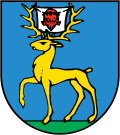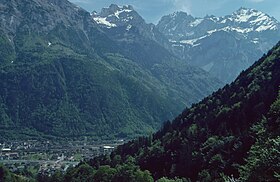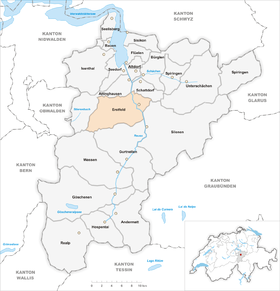Erstfeld
| Erstfeld | |
|---|---|
| State : |
|
| Canton : |
|
| District : | No district division |
| BFS no. : | 1206 |
| Postal code : | 6472 |
| Coordinates : | 692 458 / 186 202 |
| Height : | 475 m above sea level M. |
| Height range : | 453-3195 m above sea level M. |
| Area : | 59.09 km² |
| Residents: | 3788 (December 31, 2018) |
| Population density : | 64 inhabitants per km² |
|
Proportion of foreigners : (residents without citizenship ) |
19.6% (December 31, 2,014) |
| Mayor : | Pia Tresch-Walker |
| Website: | www.erstfeld.ch |
|
Erstfeld seen from the Erstfeldertal |
|
| Location of the municipality | |
Erstfeld im Reuss is a municipality in the canton of Uri in Switzerland . Erstfeld is a railway station .
Erstfeld is located on one of the most important European transit axes, the pass over the Gotthard massif . Thanks to its central location, all areas of Switzerland can be reached from here in a relatively short time. With the construction and opening of the Gotthard Railway in 1882, Erstfeld grew from a small and insignificant farming village to an important railway location for all of Europe on a north-south route that crosses the Alps. A hundred years later, a car tunnel along the A 2 will replace the now only scenic pass road and in 2016 the new, like the old route, will be structurally spectacular, almost 60 km long railway tunnel ( Gotthard base tunnel ) for the accelerated passenger and transport Freight traffic inaugurated. Erstfeld has been the northern starting point for major structural interventions in the Alpine region for around 150 years .
geography
The old part of the village is on the left side of the Reus at the entrance to the Erstfeldertal, which is delimited by the Schlossberg glacier (Glattenfirn).
The western border of the municipality extends to the end of the Erstfeld valley up to the two Spannort peaks (Kleiner Spannort 3140 and Grosser Spannort 3198 m above sea level ). Most of the municipality is covered by the Erstfelder Valley and its surrounding mountain ranges. It is a left side valley of the Urner Reuss Valley and is traversed by the Alpbach . But only a very small part of the population lives in this valley. The place Erstfeld lies in the Reuss valley. Left bank districts are Taubach, Niderhofen, Leitschach and Seewadi. The village and various other quarters such as Bitzi, Rüti and Lussi are on the right bank of the Reuss.
Only 167 ha or 2.8% of the municipality is settlement area. Of this, 69 hectares are buildings, 18 hectares are industrial and 72 hectares are used for traffic. The agricultural area is more extensive with 694 hectares or a share of 11.7%. These include large alpine areas in the Erstfelder Valley and on the western slope of Bälmeten ( 2414 m above sea level ) and Schwarz Grat ( 2018 m above sea level ). They cover an area of 373 ha. There is also 311 ha of meadow and arable land. In addition, 1730 hectares or 29.2% are covered by forest and wood. Unproductive area comprises most of the municipality, more precisely 3329 ha or 56.2%. These are almost exclusively high alpine areas in the form of mountains, glaciers and other areas without vegetation.
Erstfeld borders in the west and north on Attinghausen , in the north on Schattdorf , in the east on Silenen and in the south on Gurtnellen and Wassen .
population
| year | Residents |
|---|---|
| 1743 | 614 |
| 1799 | 700 |
| 1850 | 916 |
| 1880 | 1184 |
| 1888 | 1748 |
| 1900 | 2416 |
| 1910 | 3149 |
| 1920 | 3263 |
| 1930 | 3122 |
| 1970 | 4516 |
| 1980 | 4158 |
| 2000 | 3933 |
| 2005 | 3869 |
| 2010 | 3795 |
| 2013 | 3879 |
The population reached 614 in the middle of the 18th century. In the second half of the 18th century, the population grew only slowly (1743–1799: + 14.0%). This growth then intensified in the following 51 years (1799–1850: + 30.9%). Erstfeld was on the mule route over the Gotthard. This led to a further increase in population until 1880 (1850–1880: +29.3%). The opening of the Gotthard railway line in 1882 and the establishment of a railway depot in the community led to a population explosion by 1910 (1880–1910: +166%). In the 1920s there was a small population decline, followed by a further phase of growth (1930–1970: +44.7%). Overall, the population almost quintupled in the 120 years between 1850 and 1970 (1850–1970: +3600 people or + 393%). Since the peak in 1970, there has been a marked decline in population. In the past 35 years Erstfeld lost 738 inhabitants or 16.3%. An important reason for this is the job cuts at the railways, which had a major impact on the railway village.
languages
The population speaks a highly Alemannic dialect. Almost the entire population speaks German as the everyday language. At the last census in 2000, 88.74% said German, 3.74% Serbo-Croatian and 2.39% Italian as their main language.
Religions - denominations

The population used to be fully members of the Roman Catholic Church. The denominational relationships in 2000 still show the original structure. 3,112 people were Catholic (79.13%). In addition, there were 10.25% Evangelical Reformed and 1.60% Orthodox Christians, 3.46% Muslims and 2.67% non-religious. 89 people (2.26%) did not provide any information about their creed.
Origin - nationality - citizenship
Of the 3778 residents at the end of 2005, 3309 (87.59%) were Swiss citizens (mostly German-speaking Swiss ). The majority of the 12.41% immigrated residents come from southern Europe (Italy and Portugal), Turkey, the former Yugoslavia (Serbia-Montenegro, Croatia and Bosnia-Herzegovina) and Sri Lanka. In an earlier census in 2000, 3451 people (87.74%) were citizens of Switzerland, 66 of them with a second citizenship.
age structure
The community has a high proportion of older residents. The proportion of people under the age of twenty of 22.65% of the local population is significantly below the proportion of people of senior age (60 years and older; 26.06%). The small number of residents between the ages of 20 and 29 and the high proportion of people aged 45 and over are striking. This is a consequence of the brain drain since 1970.
| Age | 0–6 years | 7-15 years | 16-19 years | 20-29 years | 30–44 years | 45–59 years | 60–79 years | 80 years and more |
|---|---|---|---|---|---|---|---|---|
| number | 276 | 420 | 195 | 427 | 877 | 713 | 804 | 221 |
| proportion of | 7.02% | 10.68% | 4.96% | 10.86% | 22.30% | 18.13% | 20.44% | 5.62% |
politics
legislative branch
The legislative body of the community of Erstfeld is the open community meeting, which takes place twice a year.
executive
As the executive branch , the seven-person parish council directs the affairs of the parish. He works part-time. The current mayor is Pia Tresch-Walker (as of 2017).
economy
Probably the most important employer is the railway . In 2005 there were 47 agricultural and forestry companies offering 119 jobs. Industry and trade employed 643 people in 38 workplaces, the service sector in 86 companies 870 people (employment converted to full-time positions). The 2000 census showed 57 farms and forest holdings with 194 employees. The 2001 company census came to 41 industrial and commercial enterprises with 624 and 101 service companies with 917 employees. Of the 1,739 employed people in Erstfeld in 2000, 746 (42.90%) worked in their own community. In total, the place offered jobs to 1,507 people, half of whom, more precisely 746 (49.50%), were locals.
Most of the 993 commuters do their work in other communities in the canton of Uri. 390 people worked in Altdorf, 175 in Schattdorf, 41 in Silenen, 40 in Flüelen, 32 in Bürglen UR and 21 in Seedorf UR. There was also a large number of commuters to other cantons. The most important places of work outside Uris were the city of Lucerne (39 people), the municipality of Schwyz (32), the city of Zug (19) and Ingenbohl in Schwyz (18). But there were numerous commuters, namely 761 people. These came mainly from the other municipalities in the canton of Uri. The largest number came from Schattdorf (139 people), followed by Altdorf UR (134), Silenen (122), Bürglen UR (68), Flüelen and Seedorf UR (27 each) and Attinghausen (26).
history
The first human traces on Erstfeld soil are almost 3000 years old. Centuries ago a splendid knife from the Bronze Age was found near the Jagdmatt Chapel . Erstfeld made international headlines in 1962 when two Italian guest workers discovered the gold treasure of Erstfeld at the exit of the Lochertal .
The old settlement center of Erstfeld is on the left bank of the Reuss, where the Gotthard route originally passed. Since the 13th century, the local mule haulers have passed by here with their heavily laden horses. But during this time Erstfeld was never considered an important stage. That was only to change in 1882 with the opening of the Gotthard Railway . Almost overnight, the insignificant farming village became an important railway location and, as a result, a railway village .
Extensive track systems and large railway buildings have shaped the village image ever since. The railway very quickly attracted many workers from abroad, which resulted in a real construction boom.
tourism
In addition to rail tourism and the sights, Erstfeld is known as a starting point for numerous different outdoor activities . In addition to numerous hiking trails , Erstfeld also offers numerous climbing opportunities in the immediate vicinity of the village , offering everything from easy to difficult climbing levels. It is also a starting point for high-altitude tours in the Spannort Glacier and the Maderanertal , which is bordered by the Hüfigletscher .
Bikers also have the opportunity to tackle various bike trails from Erstfeld, some of which are also listed in Switzerland Mobile and are therefore well signposted.
Attractions
Jagdmatt Chapel
One of the main attractions is the Jagdmatt Chapel, which was first mentioned in 1339. The people of Uri met here every year at the end of April for the national pilgrimage, which over the years acquired an important political character: after the solemn service, the participants gathered to discuss the agenda of the rural community, which took place a few days later. The current building in the early baroque style was built in 1637/38.
Gotthard Railway and NEAT
The opening of the Gotthard railway in 1882 was the station Erstfeld an important railway location for the locomotive changes and reproaching thrust engines for heavy trains on the uphill slope of the Gotthard railway, known as the north ramp up to the portal of the Gotthard tunnel in Göschenen .
The Erstfeld depot is an attraction for railway fans. A historical Gotthard locomotive of the type Ce 6/8 (the so-called crocodile ) was exhibited here for a long time . It is also the seat of the SBB Historical Heritage Foundation (sbb-historic). Several historic locomotives are in the depot remisiert , including the SBB Ae 6/6 no. 11402, which is the second production model to the development of this important series of mountain-electric locomotives.
As part of the major European project Neue Eisenbahn-Alpentransversale (NEAT) , the Gotthard Base Tunnel has been connecting Erstfeld directly with Bodio near Biasca in Ticino, almost horizontally through the mountain , since 2016 . The previous increase, at the time a top achievement in engineering in the 19th century, is no longer applicable for a large part of the traffic load (the mountain route will continue to be used as planned).
gold treasure
In 1962, while building a dam, two Italians discovered ornate neck and arm rings that were identified as early Celtic goldwork from the 4th century BC. The gold treasure from Erstfeld is considered to be the most important Swiss Celtic find from the La Tène period . It consists of four very finely hollow necklaces and three bracelets made of up to 95 percent pure gold weighing a total of 640 g, practically as good as new women's jewelry decorated with many animal images. There are two pairs of necklaces and bangles of the same design. The Erstfeld gold treasure is one of the outstanding masterpieces of Celtic handicraft with few comparisons in Europe north of the Alps. It is exhibited today in the Swiss National Museum in Zurich .
Scheidnössli
The Scheidnössli at the northern exit of the village is world-famous among geologists . Here one encounters fourteen different rock layers within five meters of height.
Erstfeld municipal works
The community works Erstfeld (also called EWE) is an independent public law institution and has its seat next to the community center in Erstfeld. It is responsible for the drinking water and electrical energy supply in the community of Erstfeld. It also offers numerous services for third parties and especially for the community of Erstfeld. The main services for the community are the operation and maintenance of public lighting and the operation of the district heating systems for the school buildings. The Erstfeld municipal works are also known for building solar and photovoltaic systems in the canton of Uri.
Even before the municipality's own Bocki I power plant was built, the municipality of Erstfeld had its own electrical distribution systems and transformer stations. At that time the electricity was obtained from EWA (Altdorf Electricity Works). On December 19, 1928, the nine-person study commission was commissioned to plan the Bocki I power plant. Construction was completed on September 29, 1929, and the Bocki I power plant began operating. Bocki II followed in the 1960s. At the beginning of the 21st century, the drinking water power plants were also built in the Erstfeldertal.
Personalities
- Hans Huber (1884–1973), publisher
- Helen Kasser (1913–2000), artist
- Emilie Lieberherr (1924–2011), politician
- Albert Eschenmoser (* 1925), chemist
- Beat Villiger (* 1944), doctor
- Hanspeter Müller-Drossaart (* 1955), actor
- Kurt Betschart (* 1968), cyclist
- Bruno Risi (* 1968), cyclist
Web links
- Official website of the municipality of Erstfeld
- Felix Müller, Hans Stadler: Erstfeld. In: Historical Lexicon of Switzerland .
- Hans Stadler: Jagdmatt. In: Historical Lexicon of Switzerland .
Individual evidence
- ↑ Permanent and non-permanent resident population by year, canton, district, municipality, population type and gender (permanent resident population). In: bfs. admin.ch . Federal Statistical Office (FSO), August 31, 2019, accessed on December 22, 2019 .
- ↑ https://www.pxweb.bfs.admin.ch/Selection.aspx?px_language=de&px_db=px-x-0102020000_201&px_tableid=px-x-0102020000_201\px-x-0102020000_201.px&px_type=PX
- ↑ Population statistics for the community of Erstfeld
















